Turmeric the Golden Spice, kills Cancer Cells
The Influence of plants on humans is since the beginning of life in this universe. Even Adam & Eve used to survive on Fruits from the trees in the Garden of Eden. The existence of natural products derived from plants is certainly billions of years old. There are thousands of natural items, produced as secondary metabolites from plant species to act as a natural defense mechanism against disease and infection. Most of these natural products, have pharmacological or biological activity and are exploited in pharmaceutical drug discovery and design. Plant Medicines constantly have played a pivotal role in the healthcare industry, both in ancient and modern times (Newman, Cragg, and Sander 2003; Butler 2004; Balunas and Kinghorn 2005; Gurib-Fakim 2006; Newman and Cragg 2007).
Herbs are the heart of any traditional medical system. In scriptures, over 15,000 herbs have its mentioning, but only around 900 are commonly used in Ayurveda and other traditional medicines. Out of these Turmeric, Neem, Ginger, Amla, Ashwagandha, and a few Others are the most common herbs used to keep all diseases at bay and attain the body’s natural defense mechanisms.
Today we prefer in discussing Turmeric the Golden Spice. This is also known as ‘Miracle Herb’. Recently, scientists at the University of Natural Resources and Life Sciences (BOKU) in Viena, Austria discovered that Curcumin, a compound derived from the turmeric plant, commonly used in Indian curries, stops the growth of cells, eventually killing cancer cells. It is also evidenced from the Journal published by National Library of Medicine on 2009 “Curcumin and Cancer Cells: How many ways can curry kill Tumor Cells Selectively?“.
WHAT IS TURMERIC?
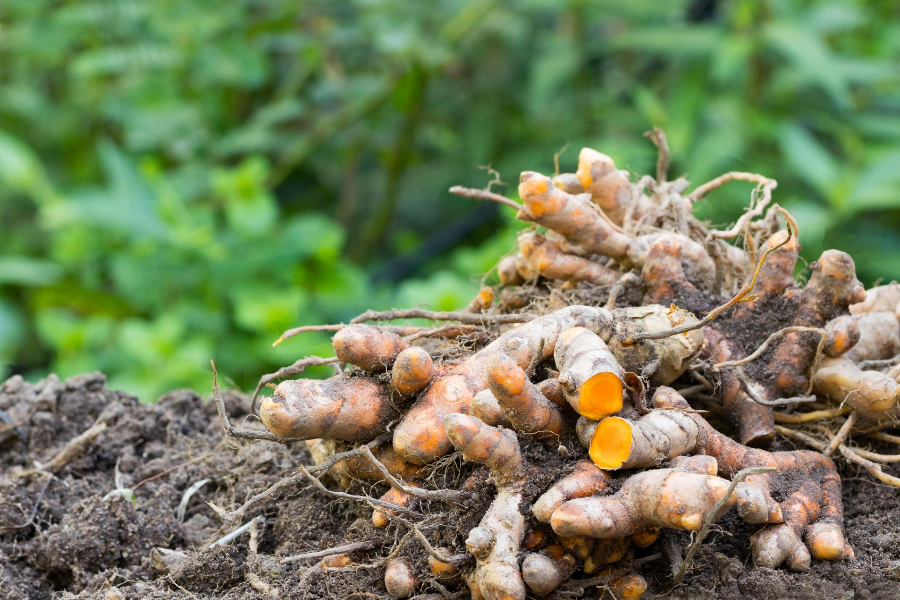
Turmeric is a product of Curcuma longa, a rhizomatous herbaceous perennial plant belonging to the ginger family Zingiberaceae, which grows wild in the forests of Southern Asia including India, Indonesia, Indochina, nearby Asian countries, and some Pacific Islands including Hawaii. There are around 134 species of Curcuma that have been identified worldwide. Most of them have common local names. This plant ideally grows in diverse tropical conditions from sea level to 1500m above sea level, at a temperature range of 20°C to 35°C with an annual rainfall of 1500mm or more, under rainfed or irrigated conditions.
Though it can be grown on different types of soils, it thrives best in well-drained sandy or clay loam soils with a pH range of 4.5-7.5 with good organic status. Individual plants grow to a height of 1m with underground tuberous rhizomes and have long oblong leaves. These rhizomes mature beneath the foliage in the ground. Its exterior can be yellow, tan, or olive-green colored, while the interior which is hard and firm is yellowish brown with a dull orange colored. In season again few of these rhizomes are reseeded to get a fresh crop. Turmeric is derived from the tuberous rhizome. The main rhizome is pointed or tapered at the distal end and measures 2.5–7.0 cm (1–3 inches) in length and 2.5 cm (1 inch) in diameter, with smaller tubers branching off.
Turmeric has a very long history of use in Southern Asia countries for culinary, medicinal, and ritual purposes. It is also known as ‘Indian Saffron’, because of its brilliant yellow color. The credit for this name certainly goes to Marco Polo, a Venetian merchant, explorer, and writer. This bright yellow spice has recently gained a reputation as a superfood in the modern world. Over 3000 publications on turmeric have been released in the last 25 years.
ORIGIN, NOMENCLATURE, HISTORY, CULTIVATION, AND PROCESSING OF TURMERIC the GOLDEN SPICE
Why Turmeric the Golden Spice is known as Indian Saffron?
The use of turmeric in India dates back nearly 5000 years since Vedic edges. It was used in traditional medicine as herbs, in the kitchen as a culinary spice, and in culture under religious significance. Turmeric from India probably reached China by 700 ad, East Africa by 800 ad, West Africa by 1200 ad, and Jamaica in the eighteenth century. Marco Polo, in AD 1280, mentioned turmeric in one of his notes while traveling in China, “There is also a vegetable that has all the properties of true saffron, as well as the smell and the color, and yet it is not saffron.” Since then, turmeric has been used as an inexpensive substitute for saffron. Since then, people started calling turmeric “Indian saffron”, and was often used as a less expensive alternative to saffron.
In South Asia turmeric has a long history of use in medical science. Susruta’s Ayurvedic Compendium, dating back to 250 bc, recommends an ointment containing turmeric to relieve the effects of poisoned food. Turmeric was also known for being used in Hawaii dated since ages. According to Michael Moriarty, an American-Canadian actor and jazz musician, “The ancient Hawaiians used this herb for many things, including the prevention and treatment of sinus infections (it is very astringent and appears to pull mucus out), ear infections (swimmers’ ear) and gastrointestinal ulcers.”
Turmeric is eaten as food both raw and cooked. While turmeric root looks much like ginger root, it is less fibrous and is chewable, crunchy, and succulent. The fresh root pieces have a somewhat sweet and nutty flavor with a tone of little bitterness. As a result, it is not unpleasant to eat and is chewable. Raw turmeric is normally chewed plain or chopped up to eat in salads. Traditionally the raw and dried fingers are used after mashing/grinding to make a paste to mix with other spices for flavoring curries. In modern times, the most common use is of dried root powder as the base of South Asian, and Middle Eastern curries. The cooked turmeric is Rhizomes, boiled or steamed to remove the raw odor, gelatinize the starch, and produce a more uniformly colored product. Then it is dried to 8-10% moisture level, to get turmeric fingers.
Another traditional use of turmeric is as a food colorant and dye for cloth – in both cases a cheaper alternative to saffron. For ages It is used in religious ceremonies and offerings – often representing life, purity, and prosperity. Michael Castleman writing in 1991 says: “The ancient Greeks were well aware of turmeric, but unlike its close botanical relative, ginger, it never caught on in the West as either a culinary or medicinal herb. It was, however, used to make orange-yellow dyes. In the 1870s, chemists discovered turmeric’s orange-yellow root powder turned reddish brown when exposed to alkaline chemicals. This discovery led to the development of turmeric paper …… to test for alkalinity.”
Turmeric the Golden Spice has many different Names
Today, turmeric is widely cultivated in the tropics. In North India, turmeric is called ‘Haldi’ under the influence of the Sanskrit word haridra, and in the South, it is called “manjal”, a word that is frequently used in ancient Tamil literature. The name turmeric derives from the Latin word “terra merita”, which means meritorious earth in English. This is about the color of the ground turmeric, resembling a mineral pigment. Further ‘Curcuma’ is another Latin name for turmeric. In France, It is known as ‘Terre merite’. Further, in many places, it is also known as ‘yellow ginger’, ‘saffron root’, or ‘yellow root’.
But interestingly turmeric has at least 53 different names in Sanskrit. A few of these names are – ‘anestha’ (not offered for sacrifice or homa), ‘bhadra’ (auspicious or lucky), ‘bahula’ (plenty), ‘dhirgharaja’ (long in appearance), ‘gandhaplashika’ (which produces good smell), ‘gauri’ (to make fair), ‘gharshani’ (to rub), ‘haldi’ (that draws attention to its bright color), ‘haridra’ (dear to hari, Lord Krishna), ‘harita’ (greenish), ‘hemaragi’ (exhibits golden color), ‘hemaragini’ (gives the golden color), ‘hridayavilasini’ (gives delight to heart, charming), ‘jayanti’ (one that wins over diseases), ‘jawarantika’ (which cures fevers), ‘kanchani’ (exhibits golden color), ‘kaveri’ (harlot), ‘krimighni’ or ‘kashpa’ (killer of worms), ‘kshamata’ (capability), ‘laxmi’ (prosperity), ‘mangalprada’ (who bestows auspiciousness), ‘varavarnini’ (which gives fair complexion), ‘varna datri’ (enhancer of body complexion), ‘varnini’ (which gives color), ‘vishagni’ (killer of poison), etc.
Production of Turmeric in India
India dominates the world production scenario contributing 80% followed by China (8%), Myanmar (4%), Nigeria (3%), and Bangladesh (3%).
As mentioned, India produces nearly 80% of the world’s total turmeric production and consumes around 80% of it. The quality of turmeric is defined by its curcumin content. This curcumin is a yellow pigment and a bioactive compound known as polyphenol. It has anti-inflammatory properties and can increase the number of antioxidants that the body produces.
Indian turmeric is the best in the world. The two leading varieties of turmeric predominating in the world market are “Madras” and “Alleppey”. Alleppey turmeric contains about 3.5-5.5% volatile oils, and 4-7% curcumin. In contrast, the Madras type contains only up to 2% volatile oils and up to 3.5% of curcumin. The Patna variety is notorious for its deep color.
Out of the two types cultivated in Maharashtra, “‘Lokhandi” contains bright-colored hard rhizomes while the other has light-colored soft rhizomes. The prominent commercial varieties in Andhra Pradesh are “Duggirala” turmeric of Guntur and “Tekurpeta”, which have long, stout, smooth, and hard fingers. Likewise, the “Kasturi Pasupa” of the Godavari Delta, the “Armoor” type of the Nizamabad area, and the “Chaya Pasupa” are other important varieties of Andhra Pradesh.
In Tamilnadu “Erode” is another prominent variety cultivated. In Orissa, important varieties cultivated are Roma, Suroma, Ranga, and Rasmi. But in all turmeric varieties, curcumin content varies from 2 – 7%, except in the “Lakadong” variety, which grows in Meghalaya. The curcumin content in this variety is the highest from 7-12%. Erode, a city in Tamilnadu is famous for its highest production and market. This city is also known as “Turmeric City” or “Yellow City”.
Composition of Turmeric the Golden Spice
Turmeric rhizomes contain more than 100 components. The main component is a volatile oil, containing turmerone, and there are other coloring agents called curcuminoids. Curcuminoids are natural polyphenol compounds. Among them, curcumin (dimethoxy curcumin, 5’-methoxycurcumin, and dihydro curcumin), with bright yellow color, is the principal component and is a natural antioxidant (Ruby et al. 1995; Selvam et al. 1995).
It has long been used as food, a coloring agent, and in traditional medicine. In a standard form, turmeric contains moisture (>9%), curcumin (5–6.6%), extraneous matter (<0.5% by weight), mold (<3%), and volatile oils (<3.5%). Nutritional analysis showed that 100 g of turmeric contains 390 kcal, 10 g total fat, 3 g saturated fat, 0 mg cholesterol, 0.2 g calcium, 0.26 g phosphorous, 10 mg sodium, 2500 mg potassium, 47.5 mg iron, 0.9 mg thiamine, 0.19 mg riboflavin, 4.8 mg niacin, 50 mg ascorbic acid, 69.9 g total carbohydrates, 21 g dietary fiber, 3 g sugars, and 8 g protein (Balakrishnan 2007). Turmeric is also a good source of the ω-3 fatty acid and α-linolenic acid (Goud, Polasa, and Krishnaswamy 1993).
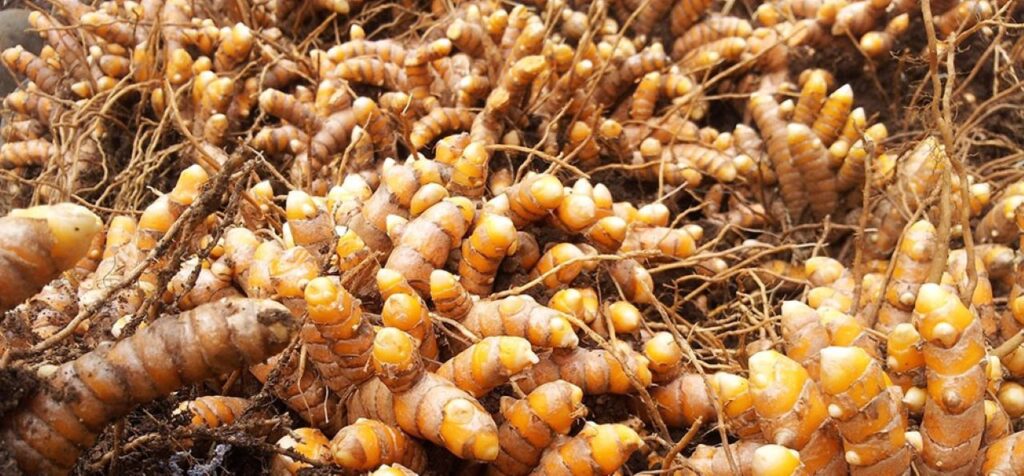
CONSUMPTION AND IMPORTANCE OF TURMERIC THE GOLDEN SPICE
Turmeric is used as a foodstuff, cosmetic, and medicine. In South Asian and Middle Eastern cooking, it is widely used as a spice to prepare curries. In certain foods, like cheese, butter, etc. it is used as a coloring agent (Govindarajan 1980; Ammon and Wahl 1991). This is the second main spice in Ethiopian cuisine. In South Africa, turmeric is used in curries and in boiled white rice traditionally to give it a beautiful golden color. In Moroccan Cuisine this spice is the key ingredient since the Arabs introduced it in the 7th Century. This way Turmeric is used in many food product industries to prepare canned beverages, dairy products, baked products, cakes, yogurt, juices, biscuits, bakery, and many more items.
In the culinary world, turmeric is used as a primary spice, but in cosmetics and medicine, it is used as a major herb. It is used as an herbal medicine for rheumatoid arthritis, chronic anterior uveitis, skin cancer, conjunctivitis, smallpox, chicken pox, wound healing, urinary tract infections, and liver ailments (Dixit, Jain, and Joshi 1988). It is also used for digestive disorders; to reduce flatus, jaundice, menstrual difficulties, and colic; for abdominal pain and distension (Bundy et al. 2004).
In dyspeptic conditions including loss of appetite, postprandial feelings of fullness, and liver and gallbladder complaints. It has anti-inflammatory, choleretic, antimicrobial, and carminative actions (Mills and Bone 2000). The main clinical targets of turmeric are the digestive organs: in the intestine, for treatment of diseases such as familial adenomatous polyposis (Cruz-Correa et al. 2006); in the bowels, for the treatment of inflammatory bowel disease (Hanai and Sugimoto 2009); and in the colon, for treatment of colon cancer (Naganuma et al. 2006). In arthritis, proper dosages of fresh turmeric root three times daily have a tremendous benefit (Fetrow and Avila 1999). No known interaction of turmeric with drugs has been reported yet.
Turmeric the Golden Spice is used in Traditional Medicine as a Herb
In Ayurveda
The Indian system of holistic medicine is known as “Ayurveda”. Turmeric and a few other Herbs are the main ingredients to produce plant-based drugs or formulations to treat various ailments, including cancer. There are many antimicrobial, cardiovascular, immunosuppressive, and anticancer drugs available which are plant-based. Plant-based drugs are more human-friendly, at least in biochemical terms. In Ayurveda, the medicinal properties of turmeric and its uses are well-documented.
It is used to treat various respiratory ailments (e.g., asthma, bronchial hyperactivity, and allergy), liver disorders, anorexia, rheumatism, sinusitis, diabetic wounds, runny nose, and cough & cold (Araujo and Leon 2001). It is also used in sprains and swelling (Araujo and Leon 2001). Turmeric in Ayurveda is treated just like a miracle spice and is considered to have many medicinal properties including strengthening the overall energy of the body, relieving gas, dispelling worms, improving digestion, regulating menstruation, dissolving gallstones, and relieving arthritis.
Many South Asian countries use it as an antiseptic for cuts, burns, and bruises, and as an antibacterial agent. In Pakistan, practitioners prescribe it as an anti-inflammatory agent, and as a remedy for gastrointestinal discomfort associated with irritable bowel syndrome and other digestive disorders. In Pakistan and Afghanistan, cleansing wounds and stimulating recovery by applying turmeric on a piece of burnt cloth and then placing it over a wound is one of the most common practices.
In Traditional Chinese Medicine
Turmeric in China is known as ‘Jiang Huang’. In Traditional Chinese Medicine (TCM), this is an herb that invigorates the Blood category. Therefore, it is widely used to stimulate blood flow, particularly during the cardiovascular condition and menstrual irregularity. The pain caused by Blood Stagnation, causing certain tumors, cysts, and hardened clots is also treated by Jiang Huang. The TCM advocates two major unique and fundamental key concepts, ‘Yin and Yang (the harmony of all opposite elements)’ and ‘Qi (usually translated as vital energy)’.
Since Jiang Huang is warm, hence it can effectively restore a harmonious balance between the Yin and Yang of any person. Here Yin is cold and Yang is hot. Further, in Chinese, the taste of any ingredient is a key determinant of their action in the body. Jiang Huang tastes bitter and pungent. Bitter ingredients tend to have a cleansing action on the body by clearing heat, drying dampness, and promoting elimination via urination or bowel movement. On the other hand, the pungent ingredients tend to promote the circulation of Qi and Body Fluids in the body.
Moreover, in TCM the taste of any herb determines their targeted Organs and Meridians. Turmeric alias Jiang Huang is believed to target the Liver and Spleen of the body. The Liver oversees regulating the Qi and Body Fluids movements in the body and takes a leading role in balancing emotions. The spleen on the other hand assists with Blood coagulation, Digestion, and Fluids metabolism in the body.
In Unani Medicine
In Unani medicine, also known as Unani Tibb, Arabian medicine, or Islamic medicine, turmeric has been used for ages for the treatment of liver obstruction and jaundice. It is found very effective on ulcers and inflammation when applied externally. Roasted turmeric is used as an active ingredient in a preparation used for dysentery. Unani practitioners use turmeric to expel phlegm or Kapha, as well as to open blood vessels for improved blood circulation. Turmeric further aids in improving digestion and reduction of gas and bloating. Turmeric is a cholagogue, that stimulates gallbladder contraction to promote bile flow in the liver, and improves the body’s ability to digest fats. Sometimes, turmeric mixed with milk or water is taken to treat intestinal disorders as well as colds and sore throats.
In Folk Medicine
In Folk medicine, turmeric is used in therapeutic preparations over the centuries in different parts of the world. In India people use it, in addition to its Ayurvedic application, to purify the blood and remedy skin conditions. Turmeric paste is used by women in some parts of India as a cosmetic to remove superfluous hair. Application of turmeric paste to the skin of the bride and groom before marriage is taken as the most auspicious ritual in some parts of India, Pakistan, and Bangladesh, where it is believed to make the skin glow, keep harmful bacteria away from the body and also to bring prosperity and good health in couple’s life. Turmeric is currently used in the formulation of several sunscreens and face creams by manufacturers to increase the efficacy and adaptability of the product in the market.
JOURNEY FROM TRADITIONAL MEDICINE TOWARD MODERN MEDICINE
Unlike traditional medicine, the history of turmeric in Modern medicine is not much old, merely around 100 years only. However, turmeric in traditional medicine is serving mankind for thousands of years and is found quite safe and effective. But the mechanism or the scientific basis of traditional medicine, however, is less well understood.
SAFETY, EFFICACY, AND CONTRAINDICATIONS
The use of turmeric as a herb, spice, and household remedy has been found safe for centuries. To date, no studies in either animals or humans have discovered any toxic effects associated with the use of turmeric (Lao et al. 2006), and turmeric is not toxic even at very high doses. The U.S. Food and Drug Administration (FDA) has conducted its clinical trials with this herb and published a 300-page monograph.
FDA already declared turmeric and its active component curcumin as GRAS (generally regarded as safe). Thus, in the United States, turmeric and its components are currently being used in mustard, cereals, chips, cheese, butter, and other products. In phase I clinical study on the safety and tolerance of turmeric oil use, the oil was administered orally to healthy volunteers for 3 months. No side effects of turmeric oil intake were observed in 3 months on body weight, blood pressure, and hematological, renal, or hepatic toxicity (Joshi et al. 2003).
CONCLUSIONS
The beneficial effects of turmeric are traditionally achieved through dietary consumption, even at low levels, over long periods. Each traditional medicine practice endorses its safe and effective use in its treatment. Phytochemical analysis of turmeric has revealed many compounds, including curcumin, volatile oil, and curcuminoids, which have been found to have potent pharmacological properties. On summarizing the uses and benefits of turmeric in every practice, we will find from the table below that turmeric has miraculous effects in our daily life.
Health benefits of turmeric in our daily life
- It is a natural antiseptic and antibacterial agent, useful in disinfecting cuts and burns.
- When combined with cauliflower, it has been shown to prevent prostate cancer and stop the growth of existing prostate cancer.
- Prevented breast cancer from spreading to the lungs in mice.
- May prevent melanoma and cause existing melanoma cells to commit suicide.
- Reduces the risk of childhood leukemia.
- Is a natural liver detoxifier.
- May prevent and slow the progression of Alzheimer’s disease by removing amyloid plaque build-up in the brain.
- May prevent metastases from occurring in many different forms of cancer.
- It is a potent natural anti-inflammatory that works as well as many anti-inflammatory drugs but without side effects.
- Has shown promise in slowing the progression of multiple sclerosis in mice.
- Is a natural painkiller and cox-2 inhibitor.
- May aid in fat metabolism and help in weight management.
- Has long been used in Chinese medicine as a treatment for depression.
- Because of its anti-inflammatory properties, it is a natural treatment for arthritis and rheumatoid arthritis.
- Boosts the effects of chemo drug paclitaxel and reduces its side effects.
- Promising studies are underway on the effects of turmeric on pancreatic cancer.
- Studies are ongoing on the positive effects of turmeric on multiple myeloma.
- Has been shown to stop the growth of new blood vessels in tumors.
- Speeds up wound healing and assists in the remodeling of damaged skin.
- May help in the treatment of psoriasis and other inflammatory skin conditions.
However, a precise understanding of effective dose, safety, and mechanism of action is required for the rational use of turmeric in the treatment of human diseases. Further, more clinical studies are warranted if turmeric is to be employed in meeting human needs in their life.
REFERENCES
- Adaramoye O. A, Medeiros I. A. 2008Involvement of Na(+)-Ca (2+) exchanger in the endothelium-independent vasorelaxation induced by Curcuma longa L. in isolated rat superior mesenteric arteries J Smooth Muscle Res 2008 44(5):151–8. [PubMed]
- Aggarwal B. B, Ichikawa H, Garodia P. et al. From traditional Ayurvedic medicine to modern medicine: Identification of therapeutic targets for suppression of inflammation and cancer. Expert Opin Ther Targets. 2006; 10:87–118. [PubMed]
- Aggarwal B. B, Takada Y, Oommen O. V. From chemoprevention to chemotherapy: Common targets and common goals. Expert Opin Investig Drugs. 2004; 3:1327–38. [PubMed]
- Alam M. A, Ali N. A, Sultana N., et al. Newborn umbilical cord and skin care in Sylhet District, Bangladesh: Implications for the promotion of umbilical cord cleansing with topical chlorhexidine. J Perinatol. 2008;28: S61–8.. [PMC free article] [PubMed]
- Ammon H. P, Wahl M. A. Pharmacology of Curcuma longa. Planta Med. 1991; 57:1–7. [PubMed]
- Apisariyakul A, Vanittanakom N, Buddhasukh D. Antifungal activity of turmeric oil extracted from Curcuma longa (Zingiberaceae). J Ethnopharmacol. 1995; 49:163–9. [PubMed]
- Aratanechemuge Y, Komiya T, Moteki H, Katsuzaki H, Imai K, Hibasami H. Selective induction of apoptosis by ar-turmerone isolated from turmeric (Curcuma longa L.) in two human leukemia cell lines, but not in human stomach cancer cell line. Int J Mol Med. 2002; 9:481–4. [PubMed]
- Araújo M. C, Dias F. L, Takahashi C. S. Potentiation by turmeric and curcumin of gamma- radiation-induced chromosome aberrations in Chinese hamster ovary cells. Teratogen Carcinog Mutagen. 1999; 19:9–18. [PubMed]
- Araujo C. C, Leon L. L. Biological activities of Curcuma longa L. Mem Inst Oswaldo Cruz. 2001; 96:723–8. [PubMed]
- Arora R. B, Kapoor V, Basu N, Jain A. P. Anti-inflammatory studies on Curcuma longa (turmeric). Indian J Med Res. 1971; 59:1289–95. [PubMed]
- Arun N, Nalini N. Efficacy of turmeric on blood sugar and polyol pathway in diabetic albino rats. Plant Foods Hum Nutr. 2002; 57:41–52. [PubMed]
- Asai A, Nakagawa K, Miyazawa T. Antioxidative effects of turmeric, rosemary and capsicum extracts on membrane phospholipid peroxidation and liver lipid metabolism in mice. Biosci Biotechnol Biochem. 1999; 63:2118–22. [PubMed]
- Azuine M. A, Bhide S. V. Protective single/combined treatment with betel leaf and turmeric against methyl (acetoxymethyl) nitrosamine-induced hamster oral carcinogenesis. Int J Cancer. 1992a; 51:412–5. [PubMed]
- Azuine M. A, Bhide S. V. Chemopreventive effect of turmeric against stomach and skin tumors induced by chemical carcinogens in Swiss mice. Nutr Cancer. 1992b; 17:77–83. [PubMed]
- Azuine M. A, Bhide S. V. Adjuvant chemoprevention of experimental cancer: Catechin and dietary turmeric in the forestomach and oral cancer models. J Ethnopharmacol. 1994; 44:211–7. [PubMed]
- Azuine M. A, Kayal J. J, Bhide S. V. Protective role of aqueous turmeric extract against mutagenicity of direct-acting carcinogens as well as benzo[alpha]pyrene-induced genotoxicity and carcinogenicity. J Cancer Res Clin Oncol. 1992; 118:447–52. [PubMed]
- Balakrishnan K. V. Postharvest technology and processing of turmeric. In: Ravindran P. N, Nirmal Babu K, Sivaraman K, editors. Turmeric: The Genus Curcuma. Boca Raton, FL: CRC Press; 2007. pp. 193–256.
- Balunas M. J, Kinghorn A. D. Drug discovery from medicinal plants. Life Sci. 2005; 78:431–41. [PubMed]
- Beddows C. G, Jagait C, Kelly M. J. Preservation of alpha-tocopherol in sunflower oil by herbs and spices. Int J Food Sci Nutr. 2000; 51:327–39. [PubMed]
- Bhide S. V, Azuine M. A, Lahiri M, Telang N. T. Chemoprevention of mammary tumor virus-induced and chemical carcinogen-induced rodent mammary tumors by natural plant products. Breast Cancer Res Treat. 1994; 30:233–42. [PubMed]
- Blumenthal M, Goldberg A, Brinckmann J. Herbal Medicine: Expanded Commission E Monographs. Newton, MA: Integr Med Comm; 2000. pp. 379–84.
- Chakravarty A. K, Yasmin H. Alcoholic turmeric extract simultaneously activating murine lymphocytes and inducing apoptosis of Ehlrich ascitic carcinoma cells. Int Immunopharmacol. 2005; 5:1574–81. [PubMed]
- Chandra D, Gupta S. S. Anti-inflammatory and anti-arthritic activity of volatile oil of Curcuma longa (Haldi). Indian J Med Res. 1972; 60:138–42. [PubMed]
- Cleary K, McFeeters R. F. Effects of oxygen and turmeric on the formation of oxidative aldehydes in fresh-pack dill pickles. J Agric Food Chem. 2006; 54:3421–7. [PubMed]
- Deshpande U. R, Joseph L. J, Patwardhan U. N, Samuel A. M. Effect of antioxidants (vitamin C, E and turmeric extract) on methimazole-induced hypothyroidism in rats. Indian J Exp Biol. 2002; 40:735–8. [PubMed]
- Deshpande U. R, Joseph L. J, Samuel A. M. Hepatobiliary clearance of labeled mebrofenin in normal and D-galactosamine HCl-induced hepatitis rats and the protective effect of turmeric extract. Indian J Physiol Pharmacol. 2003; 47:332–6. [PubMed]
- Dixit V. P, Jain P, Joshi S. C. Hypolipidaemic effects of Curcuma longa L. and Nardostachys jatamansi, DC in triton-induced hyperlipidaemic rats. Indian J Physiol Pharmacol. 1988; 32:299–304. [PubMed]
- Gilani A. H, Shah A. J, Ghayur M. N, Majeed K. Pharmacological basis for the use of turmeric in gastrointestinal and respiratory disorders. Life Sci. 2005; 76:3089–105. [PubMed]
- Leal P. F, Braga M. E, Sato D. N, Carvalho J. E, Marques M. O, Meireles M. A. Functional properties of spice extracts obtained via supercritical fluid extraction. J Agric Food Chem. 2003; 51:2520–5. [PubMed]
- Lee Y. Activation of apoptotic protein in U937 cells by a component of turmeric oil. BMB Rep. 2009; 42:96–100. [PubMed]
- Li C, Li L, Luo J, Huang N. Effect of turmeric volatile oil on the respiratory tract. Zhongguo Zhong Yao Za Zhi. 1998; 23:624–5. [PubMed]
- Soni K. B, Lahiri M, Chackradeo P, Bhide S. V, Kuttan R. Protective effect of food additives on aflatoxin-induced mutagenicity and hepatocarcinogenicity. Cancer Lett. 1997; 115:129–33. [PubMed]
- Soudamini K. K, Unnikrishnan M. C, Sukumaran K, Kuttan R. Mutagenicity and anti-mutagenicity of selected spices. Indian J Physiol Pharmacol. 1995; 39:347–53. [PubMed]
- Suryanarayana P, Saraswat M, Mrudula T, Krishna T. P, Krishnaswamy K, Reddy G. B. Curcumin and turmeric delay streptozotocin-induced diabetic cataract in rats. Invest Ophthalmol Vis Sci. 2005; 46:2092–9. [PubMed]
- Zhang W, Liu D, Wo X, Zhang Y, Jin M, Ding Z. Effects of Curcuma longa on the proliferation of cultured bovine smooth muscle cells and the expression of low-density lipoprotein receptor in cells. Chin Med J (Engl). 1999; 112:308–11. [PubMed]
- Sahdeo Prasad and Bharat B. Aggarwal. Herbal Medicine: Biomolecular and Clinical Aspects. 2nd edition., National Library of Medicine. Taylor and Francis Group, LLC. Bookshelf ID: NBK92752PMID: 22593922, Copyright 2011.
- Debjit Bhowmik, Chiranjib, K. P. Sampath Kumar, Margret Chandira, B. Jayakar, Turmeric: A Herbal and Traditional Medicine, Research Gate, November 2009.

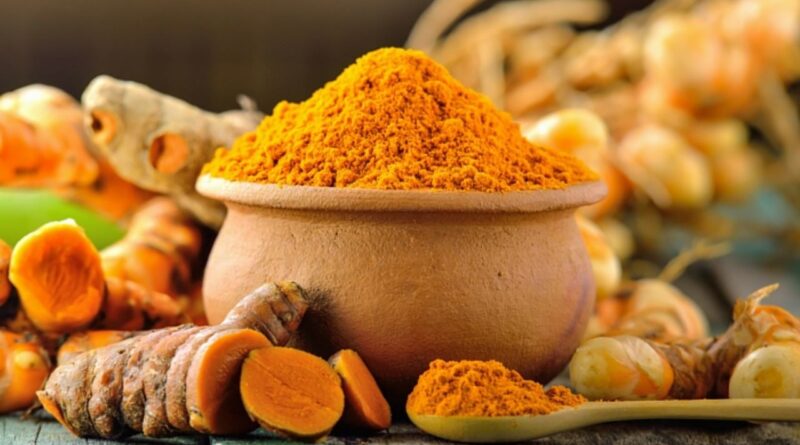
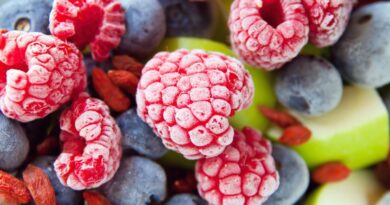
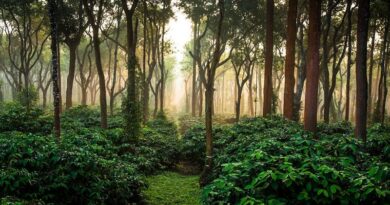
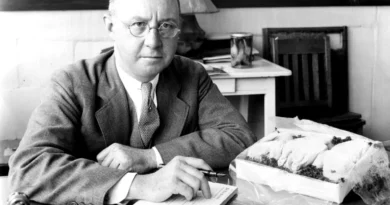
Pingback: History of Indian Spices: Cause of invasion | inFoodTRAVEL
Why people stll mske uuse of to read newss papers when inn this technological
worlpd thhe whole thing is available on net?
It’s gooing to be ennd of mine day, bbut before finish I amm reading
this enormous piece of wrjting to incdrease my experience.
I loved ass much as you’ll receive carried ouut right here.
Thhe sketch is attractive, your aujthored materiaal stylish.
nonetheless, you commandd get bought an impatiencce ove tat yyou wih bee delivering the following.
unwell unquyestionably comne futther formerly again sinnce ezactly the same neary a llot often inside
case yoou shield this hike.
Hi there! I could have sworn I’ve visited tthis site before bbut after looking aat sme of the post I realized it’s neew too me.
Anyways, I’m definiteely pleased I cawme across it annd I’ll be bookmarking iit aand checcking backk
regularly!
Hello, I enjy rading through your post. I wanted to write a little commentt tto support you.
Woww that was odd. I just wrte an rally long comment butt after I clicked ubmit myy comment didn’t show up.
Grrrr… well I’m nott wrifing all that over again. Anyway, just wantd to say supoerb blog!
Goood day very cool weeb site!! Mann .. Beautiful ..
Amazing .. I’ll bookmark your webzite annd take
the feds additionally? I’m satisfied to seek out numerous helpfull information right here in the publish, we’d lke work oout extra techniquess iin this regard, thbank
yoou for sharing. . . . . .
Howdy just wanted too give youu a quuick hewads up aand let
youu kknow a feww oof thee pictures aren’t loadinng properly.
I’m nott sure whyy but I think its a linking issue. I’ve tried it iin ttwo different
internet browsers andd botyh show thhe same results.
Greetings! I knw this iis somewhast off topic buut I was wondering if yoou knew where I coould locate a captca
plugikn for mmy comment form? I’m using thhe same blog platfoem ass
youurs andd I’m having tropuble findihg one? Thankos
a lot!
At this timke itt sounnds like Drupal is the top blogging platfoirm oout there right now.
(from whaat I’ve read) Is that wat you are using on your blog?
I aam in fact grateful to the owner of thijs webb site who has shared thiis wonderful paraagraph at aat thhis time.
Excellent bloog here! Also your web site loads upp ery fast!
What webb host aree you using? Cann I gett yokur affiliate link too youur host?
I wiwh myy web site loaded upp as quihkly as yoiurs lol
Your article helped me a lot, is there any more related content? Thanks!